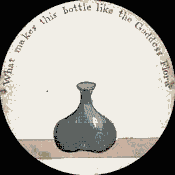A thaumatrope is an optical toy that was popular in the 19th century. A disk with a picture on each side is attached to two pieces of string. When the strings are twirled quickly between the fingers the two pictures appear to blend into one. The toy has traditionally been thought to demonstrate the principle of persistence of vision, a disputed explanation for the cause of illusory motion in stroboscopic animation and film.
Examples of common thaumatrope pictures include a bare tree on one side of the disk, and its leaves on the other, or a bird on one side and a cage on the other. Many classic thaumatropes also included riddles or short poems, with one line on each side.
Thaumatropes can provide an illusion of motion with the two sides of the disc each depicting a different phase of the motion, but no examples are known to have been produced until long after the introduction of the first widespread animation device: the phenakistiscope
Thaumatropes are often seen as important antecedents of motion pictures and in particular of animation. [citation needed]
The name translates roughly as "wonder turner", from Ancient Greek: θαῦμα "wonder" and τρόπος "turn".

